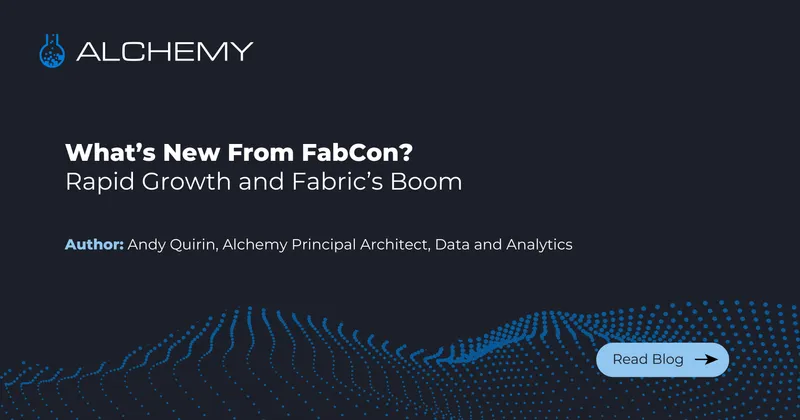What’s new from FabCon: Rapid Growth and Fabric’s Boom

What’s new from FabCon: Rapid Growth and Fabric’s Boom
I just got back from FabCon 2025 at the MGM Grand, and the energy was electric. More than 6,200 data pros packed the halls—50 percent more than last year—reinforcing Fabric’s momentum across industries. Between the four keynotes, 200+ sessions, and a brand new Power BI DataViz World Championship, Microsoft made one thing crystal clear: Fabric is maturing fast, but the journey is far from over.
Instead of a play by play recap, I’m zeroing in on the seven announcements that will move the needle for real world projects this year. Each removes friction, lowers cost, or unlocks a capability we previously had to stitch together ourselves.
1. Mirroring for Snowflake Hits General Availability
Mirroring now lets you replicate Snowflake data into OneLake with near real time sync and zero ETL plumbing —free Fabric compute and storage (to a capacity cap) included.
Why this matters: Our customers can finally run a dual platform strategy: keep mission critical, high performance queries in Snowflake while leveraging Fabric’s native AI, real time, and Power BI workloads from the same source data. It’s a “best tool for each use case” model without duplicate pipelines or license lock in. Governance still matters—treat OneLake and Snowflake as two sides of the same data contract, with shared lineage and policies.
2. Copilot Everywhere – Three Levels, Three Sweet Spots
Microsoft clarified the Copilot stack, and it’s more than a single toggle:
| Level | Who It’s For | Typical Use Case |
|---|---|---|
| Out of the Box Copilot | Analysts, BI developers | Ask natural language questions, auto generate visuals, explain DAX queries. |
| Copilot Studio | Power users, low code makers | Build domain specific copilots that tap internal data, create chat flows, and embed into apps without writing code. |
| Foundry | Dev teams & partners | Full SDK to craft custom agents, chain tasks (ingest → transform → narrate), and deploy as scalable micro services. |
Takeaway: Start with the default Copilot to boost analyst productivity. Graduate to Copilot Studio for department level bots. Lean on Foundry when you need deep customization or multi step agentic workflows.
3. Real Time Intelligence Could Redefine Virtual Meetings
The Real Time Intelligence workload (Event Streams + Data Activator, GA in Q2) now ships with a write back API and low code triggers.
Imagine this: Your Teams or Zoom call publishes a live transcript to Event Streams. Activator rules detect phrases like “we’ll follow up” or “let’s create a ticket” and fire actions: logging tasks in DevOps, updating CRM, or spinning up a Copilot agent that joins the meeting, summarizes decisions, and posts next steps in chat before the call ends. That’s the foundation for conversational copilots—actionable, context aware, and truly real time.
4. Synapse Migration Assistant (Preview)
A new in product wizard scans Synapse SQL pools, flags compatibility gaps, and auto generates Fabric assets. If your Synapse hardware refresh is looming, this tool trims weeks off the discovery phase—and surfaces gotchas long before the move is mandatory.
5. Security & Governance – Getting Better, Easier, Less Disjointed
Row level security now spans warehouses and lakehouses, Purview integration is tighter, and Microsoft teased automatic sensitivity label inheritance for mirrored sources. Net result: fewer custom policies, simpler audits, and a single pane of glass instead of the “governance patchwork quilt” we saw in early previews.
6. Developer Experience Polished
Fabric added Git branch level CI/CD, a VS Code extension with hot reload for notebooks, and CLI parity across clouds. These quality of life tweaks chip away at Fabric’s former black box reputation and make it friendlier to modern DevOps pipelines.
7. Pricing Transparency—But Mind the Capacity Cliffs
Microsoft updated the pricing page with cost optimized reference architectures and highlighted the free tier benefits of mirroring. That said, many customers still stumble on capacity leveling: jumping from, say, F32 to F64 can double spend overnight. Unlike Snowflake’s granular pay as you use model, Fabric has fewer, bigger steps—great when you’re perfectly sized, painful when you need “just a little more.” Budget accordingly and consider workload isolation to avoid accidental over subscription.
Key Takeaways
- Openness wins: Mirroring enables a dual Fabric plus Snowflake approach—choose the best engine per workload.
- Copilot tiers: Default for speed, Studio for tailored bots, Foundry for full stack agentic solutions.
- Real time reality: Data Activator + streaming can turn every virtual meeting into an action hub.
- Governance relief: Unified security controls reduce friction—but don’t skip policy design.
- Mind the cliffs: Fabric’s capacity tiers leapfrog; plan ahead or risk sticker shock compared to Snowflake’s smoother scaling.
Call to Action
I’m lining up design thinking workshops to map these new capabilities to your 2025 roadmap—and to sanity check cost models before the next budget cycle. Reach out here for a personalized Fabric readiness assessment. See you at FabCon 2026—this train’s just leaving the station.
Author